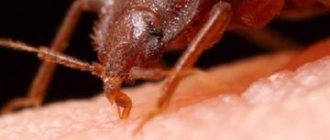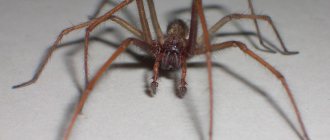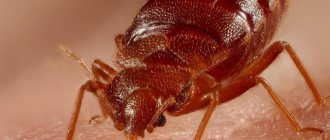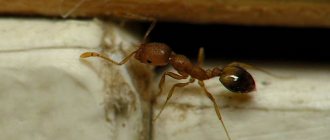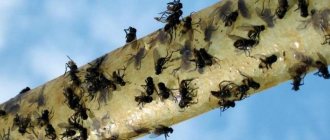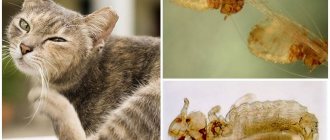Why do spiders appear in the house?
As a rule, insects live in the natural environment, including spiders.
If they prefer to live not on the street, but in a person’s home, this means that the living conditions are suitable for them. The diet of eight-legged arthropods includes various insects, such as cockroaches, flies, mosquitoes, etc.
In short, whatever gets into the web, the spider will happily eat it. The presence of insects in the house is evidence that general cleaning is rarely carried out in the house and pests, which are food for spiders, settle in hard-to-reach places.
Proven ways to get rid of
To get rid of arachnids in your home, you must first deprive them of their food source. To do this, you need to remove all bugs, flies and other insects. To do this you need to do the following:
- Close all cracks in doors, floors and windows;
- Clean residential and non-residential premises. Spiders live in unkempt places;
- Ventilation systems need to be equipped with grilles with small cells;
- On an ongoing basis, you need to wet clean the house, removing cobwebs;
- It is necessary to pay special attention to hard-to-reach places under furniture, behind cabinets, under washbasins;
- Clean the porch and cracks on the balcony;
- Deprive insects of their food source.
Ways to get into the house
We’ve dealt with the most common types of arthropods, now it’s time to find out where spiders come from in an apartment or house. According to the observations of scientists, spiders enter a living space in one of the following ways:
- through an open window;
- through the door;
- from the basement;
- on clothes;
- from the attic;
- hiding in flowers purchased in a store or collected from nature.
Through the window
An open window is the main entrance to your apartment for a large number of living creatures, including spiders. They can climb up on their own or be carried away by a strong gust of wind, tearing the unlucky arthropod off the nearest bush. Most spiders try to weave webs in the immediate vicinity of window openings, as they serve as a constant source of arthropod food.
Through the door
Try not to keep the doors to the street open for a long time if you do not want to find a spider under your nose. The entrance and street are their favorite habitats. If you keep the door open for too long, the appearance of spiders in the apartment is inevitable.
Attic
The attic, in most cases, is a cluttered room, which is much easier to get into from the street than into the house. If you have an attic space above your head, it could be the main reason why there are a lot of spiders in your apartment. Caulk all cracks through which arthropods can enter the room.
Basement
Don't know where spiders come from in your house or apartment? Turn your attention to the basement. It is full of food for arthropods, and they can easily move from it to the apartment, in search of new hunting grounds.
Through clothes
Clothing is often used by spiders as a way to enter a living space. It is difficult for a person to track the moment when a spider, blown from a tree by a gust of wind, falls on his back or trousers. During outdoor recreation, people spend a long time in contact with the ground and grass, which wild arthropods will not fail to take advantage of. When returning from picnics and hikes, check your clothing for unwanted passengers.
On flowers bought, brought from the street
Spiders often enter a living space along with flowers brought from the street or a store. Due to their small size, spiders are difficult to see in folds and hidden places formed when the stems intertwine.
Spiders in the apartment - types, photos
Every housewife, stumbling upon a web while cleaning, is once again perplexed as to where spiders come from in a seemingly completely enclosed room.
The answer to the question is very simple - they get there from the street one way or another. The body of the spider is small and usually has a gray color, so it is almost invisible on clothing. Returning from a walk, you can easily carry a couple of arthropods on your jacket into your apartment. A small and light spider can be pushed into an open door or window by a stream of air. In addition, arthropods, in search of food, enter houses through ventilation shafts and chimneys, cracks in window frames, and technical openings.
Before declaring chemical war on spiders, you can try more humane methods. After all, they do not cause any significant harm, and they do not reproduce as quickly as bedbugs or cockroaches.
There are several ways of penetration. Most often, spiders climb into the house through open windows, doors, or cracks in the wall. The person himself can bring them indoors on his clothes, along with plants and vegetables. Spiders appear only in those houses where they can live freely and there are living creatures. If the housewife constantly waves a broom around the corners of the apartment, there is no life for arthropods in such conditions, they quickly disappear.
At the beginning of September, a new generation of spiders appears and begins their mass migration. They form a web, go down it, and wait for a gust of wind. With the first breath they set off on a journey. How far and long it will be cannot be predicted in advance, since there are too many obstacles on the way. Some fall near a nearby bush, other spiders fly on their webs in the air for several kilometers, reaching private, multi-story buildings.
If there are cobwebs in the corners of the rooms, behind the furniture, or on the ceiling, this means that a spider has taken up residence. You can find it right in the center of your creation. The animal weaves trapping nets at night and calmly waits for prey during the day.
Spiders in the house
The spider often settles in the bathroom, since it is almost always dark there. In the bedroom it is found on the ceiling, behind the furniture. In the kitchen, cobwebs are placed in cabinets, in the corners of the room, and on chandeliers. Lots of spiders and cobwebs in storage rooms. They like to live on windows if they do not open or ventilate.
Almost all spiders are predators; their diet consists of small animals and insects. Most often they hunt with the help of a web, when the victim is caught in the net, the spider injects poison and digestive juice into it, and after a while sucks out the solution, which is food for them. Usually, owners learn about the presence of a spider by the appearance of a web.
Spider - haymaker
The centipede, window spider or haymaker has a small round or oval abdomen up to one centimeter, 6 or 8 legs up to five centimeters long. Its nets are randomly located in corners, near windows, and often hang upside down. Insects, falling into a web, become increasingly stuck in it. The spider lies in wait for the victim and, after injecting the poison, leaves it in reserve or eats it.
Harvesting spider – photo
Gray and black house spider
Small spiders in the apartment are black or gray spiders. Their total size is about 14 mm. Their web resembles a pipe; after the victim damages the web, they restore it, so you can often see not just a mesh, but complex weaving patterns. As a rule, the female waits for prey.
Black spider – photo
Spider is a tramp
The tramp has an oval body and large paws. A distinctive feature of the species is the absence of a web. The spider attacks the victim, injects its poison, eats it and moves on. He doesn't stay anywhere for long. In Russia, this type of spider is safe, but in the tropics, the secretion released from their glands leads to poisoning and skin problems.
Hobo spider, photo
Spider - jumper
If there is a jumping spider in your apartment, it is a jumping spider. Its difference is that it has 8 eyes arranged in three rows. The patterns on the body are varied, as are the colors. It moves easily on glass thanks to its small claws and hairs on its paws. By the way, he is a vegetarian and eats only acacia.
Jumping spider, photo
The remaining species of these arthropods are found very rarely in houses and do not settle near humans.
Where do spiders come from in an apartment?
We suggest you read: Where does a computer mouse live?
Why do spiders appear in the apartment? Most often they enter the house through various cracks. Or we bring it indoors on our clothes. But if there are a lot of spiders in the apartment and all the corners are covered with cobwebs, it’s worth wondering why they live so well here. Insects prefer to live where there is a lot of food for them - flies, bedbugs, moths, cockroaches and other small parasites.
In old houses, spiders occupy attics and basements, and from there they make their way into other rooms.
Are spiders dangerous?
All (with rare exceptions) spiders are poisonous. But the harm from the bites of spiders living in our apartments is minimal for humans, thanks to their small, fragile body structure and small fangs. After a karakurt bite, the human body will be subject to neurotoxic effects. And the biggest danger from domestic species is necrosis. But most often, neither inflammation nor intoxication occurs. The bite site only needs to be treated with an alcohol-containing product or hydrogen peroxide.
Before you think about how to get rid of spiders in the house, you should find out who serves as their food source, and who needs to be kept in company with arthropods. Fighting spiders does not always happen with the help of pesticides. To begin with, try simple and effective methods, as they do not form colonies and do not multiply at record speed.
- Find out the reason for the appearance of spiders and start fighting small insects.
- Get rid of cobwebs with a broom or vacuum cleaner. Don't forget to empty the contents of the garbage disposal outside, otherwise the spider will get out and continue to weave its webs. The simplest device for collecting cobwebs is a stick with a rag wrapped around it.
- If there are too many spiders, they have time to lay eggs, which you need to look for in secluded places, for example, on furniture near the walls. Sweep them up and flush them down the drain.
- Seal cracks and crevices, glue wallpaper where necessary, install mosquito nets and screens on ventilation grilles.
- Regular cleaning will prevent the appearance of spiders.
- After repairs, usually not a single spider remains, since the smell of paint and varnish materials is unbearable for them.
- Spiders are repelled by the pungent smells of chestnuts, hazelnuts and oranges, mint, and eucalyptus. You can crush the fruits and scatter them around the room or add drops of the substance to a spray bottle and spray the apartment regularly.
- Sprinkle diatomaceous earth on the baseboards; when the insect gets on it, it quickly dies.
- Regular vinegar is highly effective. Add a few drops of vinegar to the water, pour into containers and place around the apartment.
Chemical repellents for spiders in the apartment
If the number of spiders in your home has become alarmingly large, you cannot do without the use of chemicals. Universal aerosols against spiders are ineffective. Use household preparations based on pyrethroids. Be careful when spraying, remember to take safety precautions and follow the instructions. Also remember that the poison only works when it gets on the spider’s body.
A product that is suitable for fighting spiders – “Dobrohim FOS” – has proven itself well. The drug is an acaricidal agent that allows you to destroy arachnids with a 100% guarantee. The product is safe for people, but has a lethal effect on insects.
Easy to use Butox 50. The drug is sprayed where there are especially many spiders, left for 20 minutes, then the room is ventilated and cleaned. If you decide to use Neoron, be careful; it is very dangerous to use near food products.
It happens that the use of aerosols is impossible for some reason - small children, pets, and so on. Then it is advisable to use pills - traps, inside of which poison is placed. In addition to other control methods, it is recommended to place glue traps in corners, behind cabinets, and under low furniture.
To prevent such a problem as a lot of spiders in the apartment from arising, regularly carry out high-quality cleaning, ventilate and beat out mattresses and pillows - this way there will be less dust at home. Wash lighting fixtures, pay more attention to hard-to-reach places - in corners, under furniture, in closets, especially if you rarely use them. And remember that the spider is more of a useful creature than a pest, so let all methods of control be gentle.
Big spider in the apartment
House spider
In this species, the female is 1.5-2 times larger than the male. The size of the female is about 1.2 cm, and the male is 0.9 cm. The spiders have an oblong abdomen of a yellow, beige or brown hue. Males of this species are darker in color.
We suggest you read: Someone bites in bed at night, but is not visible. Who could it be?
Spiders have powerful limbs, the longest first pair of legs, and the limbs are decorated with dark rings.
A distinctive feature of tehrania is a pattern on the back in the form of brown spots. The young do not have brown spots on their backs, characteristic of house spiders; they appear only after three molts.
Spiders have four pairs of eyes: two of them are located in the same row on the front of the cephalothorax, one pair on top and two more lateral eyes. The main eyes are the ones on top, the rest are additional. The main eyes have muscles, so they are mobile, and the additional eyes have night vision.
Spiders of this species can be found under fallen leaves, fallen tree trunks, old snags, tree bark, in hollows and grass thickets.
House spiders, as their name suggests, also live indoors. They can be found in technical rooms, cellars, basements and even in private houses and residential apartments. Spiders hide in dark corners and other secluded places, such as under furniture.
The house spider weaves an almost flat triangular web located in a horizontal plane, and the center of the web is lower, because the spider sits in it. Such a web is called a funnel web, because its shape is similar to a funnel.
House spider on hand
Should you be afraid of spiders?
Almost all residents of apartments and private houses have encountered the problem of spiders. Whether this is good or bad depends on how aware residents are of these insects. Of course, they look terrifying, indicating that the spider is bound to bite. It is this fear that always forms the basis of the fight against these insects, although no one wonders why spiders appeared in their home.
There are many myths and many superstitions associated with spiders, which speak of completely opposite factors. For many centuries, the spider has been a tool of manipulation for sorcerers and fortune tellers.
Many of them saw positive qualities in the spider, and some of them awarded spiders with exclusively negative qualities and this formed the basis of the fears of many housewives. And this is not surprising, since since childhood everyone has been told fairy tales about man-eating spiders, etc.
Therefore, the attitude towards spiders is formed on the basis of knowledge or on the basis of superstitions, which always have two sides of the coin, depending on the personal attitude towards arachnids. Some see in them some kind of sign indicating profit, good luck or a meeting with the person of their dreams, while others see adultery, a long journey, illness, failure, etc.
Species living near humans
In nature, there are several tens of thousands of species of spiders, but few of them have adapted to live near humans. Large and small arthropods prefer dry and warm rooms, spin webs in dark corners, and catch various insects.
The four most common types of spiders in homes are:
- haymaker The most common type of house spider. These are small light spiders with long legs. With age they increase in size and acquire a dark gray, almost black color. But for the most part, they don’t live to see it. Almost everyone has seen haymakers, and only a few know that they are poisonous. Harvesters cannot harm humans because they are not able to bite through our skin;
- black or gray spiders. They are less common. Their size does not exceed one and a half centimeters. They weave an unusual web in the shape of a pipe. They bite, but only in self-defense. The bite is harmless, similar to a mosquito bite, but lasts a little longer;
- tramp. It is almost impossible to find them in apartments; this species lives in rural areas. Larger than black spiders, reaching 3 cm. Very active and do not weave webs. They are aggressive and can attack and bite when meeting a person. The bite is not fatal, but painful and often causes allergies. They end up in houses by accident and try to return to their usual habitat as quickly as possible;
- horses. They move by jumping, which is where they get their name. They have a different range of colors - from light yellow to black. In addition to their method of movement, they differ from other spiders in having large eyes. Safe, timid, cannot bite through human skin even if it tries;
- white spiders. The most dangerous representatives of the spider tribe. Species whose bite can be fatal: karakurt, lives in the south of Russia and the countries of the Middle East; "White Lady", lives and breeds in Africa; "Flower Spider" - Japan, Russia, North America and Eastern Europe. All these species are rarely found indoors; they live in nature and try not to meet humans.
A small black street spider will not cause harm to an apartment or a person. The inhabitants of the home can calmly coexist with arthropods, but if they weave around the corners of the rooms and actively breed, then the necessary measures must be taken. It is enough to collect all the spiders with a vacuum cleaner, get rid of insects, and destroy clutches of eggs.
Should we undertake a radical extermination of spiders? If they are found in every corner and irritate the inhabitants, then it is necessary to get rid of them by depriving them of food. A few small spiders can be beneficial by eating dangerous insects. Exotic lovers can keep domestic arthropods as a means of getting rid of annoying flies and cockroaches.
House spiders
Types of house spiders
Spiders are predators by nature. They live all over the world except Antarctica. Insects feed on other arthropods or smaller animals.
Of all the species of spiders (more than 42 thousand) only a few are able to survive in a human home.
It is difficult to notice the presence of arthropods, since they prefer to settle in secluded corners of the apartment: behind furniture, under window sills, on the ceiling. You can recognize the type of insect by its distinctive external features and the features of its web.
Haymaker
The haymaker is also called a window spider or centipede. The body size of the animal does not exceed 1 cm. House spiders differ from other types of arthropods by the presence of long legs.
The color of the insect varies from red to brown. The belly of the harvestman is slightly darker than the back. The individual weaves its web chaotically and often settles in attics, in the corners of rooms, and on windows.
Interesting information! The harvest spider often appears in houses in the autumn, when the air temperature drops significantly.
During the day, the insect can be seen on the wall with its legs spread out to the sides - this is how the animal basks in the sun. The individual attacks people only if there is a threat to his life. The bite of a harvestman is not dangerous to humans, since this type of insect is not poisonous.
Female centipedes lay eggs in the fall or summer. They weave cocoons for eggs from their own web. Larvae emerge from eggs after 2-3 weeks. The larvae resemble the adult harvestman, but are lighter in color.
The pigtail lives up to 12 months.
To get rid of the presence of arthropods in the house, it is enough to carry out a wet general cleaning of the room.
Black house spider
The insect's usual habitat is trees. An animal can get to a person with a flow of wind through open doors and vents. Animals enter the living space by moving along the walls.
Female black house spiders are larger than males: they grow up to 3 cm (including splayed legs).
In rooms, insects hide in corners, behind furniture. In appearance, the web resembles complex, random patterns. Animals feed on other small insects: moths, cockroaches, beetles, butterflies.
Black spiders cannot actively reproduce outside their own free will. Their activity fades with the onset of winter. Wet cleaning will help you get rid of the problem in your apartment.
Large steatoda
Small arthropod (6-10 mm) black or dark brown. Females are slightly larger. There are characteristic spots on the abdomen. Males are white, females are reddish. Food: small insects. The web is sticky. They hunt at night. Steathode is poisonous. However, the poison of one individual is not enough to seriously harm a person. Still, if you are bitten, you should go to the hospital.
Hobo Spider
The house spider reveals its presence only by its web. He does not appear in bright areas of the apartment, but prefers dark corners.
Interesting fact! Vagrant spiders living in Russia do not pose any threat to human life. The Brazilian relatives of the species in question are considered very poisonous. A child dies within 15 minutes from a bite from an adult if the antidote is not administered in a timely manner.
Arthropods enter from the street accidentally: through open windows and doors. Hobo spiders have a brown body color and powerful long legs. There are dark stripes on the insect's legs.
Females of the species are always larger and more agile than males. The average lifespan of hobo spiders is 2 years, but in captivity they live much less.
Females are able to reproduce only in nature (once a year). In the apartment, the reproduction of arthropods stops.
Jumper
In total, there are 6 thousand species of jumping spiders. They got their name from their ability to jump. Unlike their relatives, individuals have good eyesight and catch prey not only with the help of a web.
The color of the insect has a varied range. The house spider has a flattened abdomen, a raised cephalothorax and massive legs. Animals live in trees and bushes. It gets into the house by chance, just like other spiders.
Jumpers are the few species of arthropods that do not spin webs. They hunt during the day.
Female racehorses lay eggs in large numbers. To do this, they weave a special cocoon. The adult guards its nest until the larvae are born.
Important! The jumper does not pose a threat to people. Because its venom is not poisonous: it only affects small insects (flies, midges, beetles).
Attic spider
Quite a large representative of house spiders (body 12 - 18 mm long). The color is dark brown. The sternum has a lighter marking with three spots on each side. Legs are hairy. The male and female are practically no different in appearance. Poisonous, but not dangerous to humans and domestic animals. Not aggressive. It can bite only in self-defense. The net is not sticky. It waits until the victim falls into the web, jumps out and attacks it.
Phalangoid folkus
A fairly common long-legged house spider. Small translucent body, brown-gray long legs. They eat insects and their own kind. Poisonous. But their poison is not dangerous for humans. There may be a slight burning sensation at the site of the bite.
White house spider
One of the most dangerous spiders living in Russia is white. House spiders live in the south of the country and are otherwise called karakurts. The insect is able to enter people's homes in the summer.
A karakurt bite causes negative reactions in humans: allergic rashes on the skin, puffiness and swelling of the damaged area of the epidermis.
Children may have breathing problems and muscle spasms.
Tegenaria brownie
The house spider (lat. Tegenaria domestica) is a species belonging to the funnel-web family. The female tegenaria spider reaches a size of 12 mm, males grow up to 9 mm. The body of the arthropod is yellow-brown. Another variety belongs to the same family - Tegenaria atrica (lat. Tegenaria atrica). It is called the attic spider, since the attic is the most common habitat of these arthropods.
Unlike grasshoppers, which are called window spiders for their predilection for well-lit places, the house spider prefers to hide in dim corners. Hunts insects using a funnel-shaped net made of spider webs. It does not attack people, but can bite if disturbed. The bite is not painful, but slight redness and swelling, if they appear, go away within half an hour.
Tarantula
Mizgir or South Russian tarantula is an arthropod from the wolf spider family. The size of the female is about 30 mm, the males are slightly smaller. The color is most often reddish-brown, but gray individuals with white markings on the abdomen and legs are also found. The entire body of the misgir is covered with hairs; this feature allows the spider to detect various vibrations, which makes it easier for it to hunt.
Mizgir cannot be called a house spider, but sometimes it is still found in the house. A tarantula bite is very painful, causing low blood pressure, dizziness, abnormal heart rhythm, and sometimes numbness in the limbs. In people prone to allergies, tarantula venom can cause angioedema and anaphylactic shock.
Little gray spider
Sometimes there are small, inconspicuous spiders in the house. Their size is no more than 9 mm, their body color is gray. These are harmless, timid creatures that hide most of the time, avoiding encounters not only with humans, but also with pets. They hunt small insects, but do not bite people.
Little gray spider
Amarobiid spider
These spiders are found almost everywhere except in the coldest and driest regions. The size of the arthropod is from 8 to 15 mm, the color is most often dark brown. They hunt insects using a web woven in the shape of a funnel. They are practically not found in residential premises, but they often settle in basements, for which they received a second name - basement spiders.
Species living near humans
In nature, there are several tens of thousands of species of spiders, but few of them have adapted to live near humans. Large and small arthropods prefer dry and warm rooms, spin webs in dark corners, and catch various insects.
The four most common types of spiders in homes are:
- haymaker The most common type of house spider. These are small light spiders with long legs. With age they increase in size and acquire a dark gray, almost black color. But for the most part, they don’t live to see it. Almost everyone has seen haymakers, and only a few know that they are poisonous. Harvesters cannot harm humans because they are not able to bite through our skin;
- black or gray spiders. They are less common. Their size does not exceed one and a half centimeters. They weave an unusual web in the shape of a pipe. They bite, but only in self-defense. The bite is harmless, similar to a mosquito bite, but lasts a little longer;
- tramp. It is almost impossible to find them in apartments; this species lives in rural areas. Larger than black spiders, reaching 3 cm. Very active and do not weave webs. They are aggressive and can attack and bite when meeting a person. The bite is not fatal, but painful and often causes allergies. They end up in houses by accident and try to return to their usual habitat as quickly as possible;
- horses. They move by jumping, which is where they get their name. They have a different range of colors - from light yellow to black. In addition to their method of movement, they differ from other spiders in having large eyes. Safe, timid, cannot bite through human skin even if it tries;
- white spiders. The most dangerous representatives of the spider tribe. Species whose bite can be fatal: karakurt, lives in the south of Russia and the countries of the Middle East; "White Lady", lives and breeds in Africa; "Flower Spider" - Japan, Russia, North America and Eastern Europe. All these species are rarely found indoors; they live in nature and try not to meet humans.
House spiders, as their name suggests, also live indoors. They can be found in technical rooms, cellars, basements and even in private houses and residential apartments. Spiders hide in dark corners and other secluded places, such as under furniture.
The house spider weaves an almost flat triangular web located in a horizontal plane, and the center of the web is lower, because the spider sits in it. Such a web is called a funnel web, because its shape is similar to a funnel.
House spider on hand
Despite the fact that the sight of spiders causes horror for many, there is even such a phobia - arachnophobia; the house spider is completely safe for humans. He will not attack a person, because he is able to estimate the size of his prey and understands perfectly well that a person cannot become his victim.
A spider's bite is poisonous, but dangerous only for insects, because the spider will not be able to bite through the skin, and there is too little poison to lead to negative consequences.
Be careful: the house spider is similar to a wandering spider that can bite a person, and its bite causes a slow-healing ulcer.
What does it eat?
A representative of the described species is capable of going without food and water for a long time. The spider's prey is insects, including their larvae. But hermits do not disdain their own relatives and small vertebrates. Unlike most other species, hermits do not resort to capturing victims using webs.
flies
Spiders lie in wait for their hunting targets, moving significantly away from the nest. Killing is carried out by injecting a toxin from special glands located on the cephalothorax.
The hunter does not resort to preserving the victim with a web, but immediately begins to process the prey, tearing the flesh with his jaws and injecting gastric juice.
Beetles
When hunting beetles, spiders expect the deadly effect of poison. After death, the victims begin to eat, turning the corpse into a comfortable position in the process of eating.
Insect larvae
The easiest prey for hermits due to their low mobility and lack of resistance.
Killing a Spider
Under no circumstances should you kill an insect, otherwise misfortune may befall the family, and all endeavors will not end in success. The spider collects all the bad things that accumulate in the house. When a person kills him, there will be no one to take away the negative.
It is a bad sign to kill an insect crawling over the body, as it notifies household members of the arrival of guests with whom they can have fun. In addition, it attracts noisy feasts and fun events. You can only kill a spider weaving a web around an icon, thereby absolving a person of his sins.
How to fight spiders
First, you need to figure out why eight-legged creatures settled at home and eliminate the living conditions for unwanted guests. As soon as the spiders do not have enough food in this home, the areas where the insects are not disturbed for a long time will disappear, they will move to a new place.
Basic rules for fighting spiders:
check the entire apartment, identify areas of habitation, especially in damp, dark rooms with a musty smell, a lot of unnecessary things and old furniture; remove cobwebs with a soft cloth wrapped around a mop. It is important to make sure that the spiders do not scatter around the rooms: it is very difficult to catch them; collect cobwebs or cocoons with spiders with a vacuum cleaner, release them on the street away from the house or take them to trash cans; you will have to close all the cracks, holes in the floor, eliminate loose areas of linoleum, repair, install a new one or replace the mosquito net if there is significant damage to the cellular surface; do general cleaning, get rid of trash, disassemble drawers and mezzanines, restore order, reduce the number of places where spiders can settle without being noticed; regularly monitor the cleanliness of the apartment, thoroughly wipe areas under the bathroom, behind cabinets, under the bed, in the corners of the room, collect small particles of cobwebs; When there is an invasion of spiders, it is useful to make cosmetic repairs in the apartment. By removing old wallpaper, baseboards, replacing cracked windows and doors, and sealing cracks, you can often reveal all the nooks and crannies where spiders hide, which makes it easier to fight them.
Folk remedies
Spiders cannot tolerate strong odors from plants and other substances. Eight-legged creatures are repelled from their homes by the aroma:
peppermint; wormwood; vinegar; oranges; essential oils of tea tree, mint or citrus; chestnuts
Chemicals
Chemical repellents for spiders in the apartment:
chalk and dust (powder) to kill crawling insects. Brands: Raptor, Mashenka, Raid, Clean House; aerosol against flying and crawling insects. Effective brands: Dichlorvos, Jiker Bun, Raid, Combat, Antimol, Raptor; gel-like compositions for application to various types of surfaces. Effective insect repellent gels: Raid, Kombat, Dohloks, Frontline, Clean House.
Ways to fight
If you have a fear of spiders and cannot live in the same room with them, you should get rid of them immediately. Means for killing spiders are divided into:
- folk;
- store-bought
The former are less effective, but safer for the environment. The latter, on the contrary, are highly reliable, but they do not contain the most useful chemicals.
Chemicals
Among the chemicals used to control arthropods are:
- Butox-50;
- Neoron;
- Raid.
Butox-50 is an insect control drug used to treat apartments and animals. You can purchase it at a pharmacy specializing in the treatment of animals. Advantages of the drug:
- a universal tool that solves a wide range of problems;
- reasonable price of the product;
- high efficiency.
Flaws:
- it is toxic to humans, and when processing the premises it is necessary to take care of personal protective equipment;
- loses effectiveness when mixed with drugs that contain phosphorus.
Mode of application:
- take 30 milliliters of the drug;
- dilute it in 10 liters of water;
- we treat an apartment with an area of up to one hundred square meters with the resulting solution;
- After spraying the drug in a room, isolate it for 20 minutes by closing the windows and doors;
- ventilate the room, and then organize wet cleaning.
Neoron is considered an extremely effective chemical that can clear a room of uninvited guests in the shortest possible time. Advantages of use:
- speed of spider destruction;
- price. For one ampoule of Neoron you will have to pay no more than 15-20 rubles.
Flaws:
- high toxicity. Because of this, Neoron is prohibited from being used in the kitchen. If the drug gets into food, there is a high probability of severe poisoning.
Raid is a spray used to control cockroaches and other insects that are food for spiders. If they have nothing to eat, they will soon leave the premises on their own.
Note! When using chemicals, follow safety regulations and use personal protective equipment.
Folk remedies
Folk remedies allow you to remove spiders from the apartment without endangering the health of the rabbits. The following methods are popular:
- use of diatomaceous earth;
- spraying the room with mint;
- use of boric acid;
- cleaning the premises.
Diatomite, or “mountain earth,” is a sedimentary rock that helps fight arthropods due to its abrasive properties. It causes severe damage to the arthropod, which is incompatible with its continued existence. It is enough to sprinkle it in a thin layer next to the baseboards, and you can forget about spiders.
Pros:
- not addictive.
Minuses:
- destruction speed.
Peppermint essential oils sprayed indoors repel insects, causing them to retreat as quickly as possible. Mint is used as follows:
- dilute a few drops of mint in water;
- spray the solution in arthropod habitats;
- To prolong the effect of mint, moisten a cotton swab with it and place it in different parts of the room. Cotton wool retains the smell longer.
Mint can be replaced with tea tree if you are allergic to it.
Boric acid is considered a budget-friendly spider repellent that is less toxic than aerosols and other store-bought chemicals. It is available at any pharmacy, and the application algorithm is extremely simple:
- dilute the powder in water;
- wipe the corners and other places where spiders may be with the solution;
- after a while they will completely disappear.
Cleaning the room is one of the simplest folk remedies to get rid of spiders. Does not require additional cash costs.
Prevention
Important points:
The basic rules are cleanliness in the house plus no food. If there are no bedbugs, cockroaches, flies, midges, small bugs, or ants in the home, then the spiders have nothing to eat; they go to other rooms in search of small insects. Another important rule is cleanliness control. In a bright, spacious, uncluttered home, with timely elimination of leaks, cleaning up crumbs on the floor, and the absence of dark corners where eight-legged creatures and various insects love to hide, hordes of spiders are unlikely to appear. Dust, debris particles, mountains of trash are factors that influence the reproduction of cockroaches, midges, flies, and mosquitoes, which are food for spiders.
Mosquito nets must be intact and fit tightly to the frames: insects can easily penetrate even through small cracks. If there are a lot of trees near the house, then you need to be more careful, regularly remove cobwebs near the windows, turn on the light in the evening only with the mosquito net closed, if the structure is hinged. It is important to monitor the condition of window units: situations occur when a plastic window does not close, does not fit tightly to the frame, or scratches surfaces. If the performance characteristics are violated, cracks appear and the mosquito net is damaged, which makes it easier for flying and crawling insects to enter the home.
Spiders in a home, especially in large numbers, are a sign of the appearance of food for eight-legged creatures. It is important to remove small insects, then the arthropods will disappear without problems. Many people have a phobia - the fear of spiders; this factor must also be taken into account. It is important to understand that instead of one small eight-sized creature, many spiders may appear, which makes it much more difficult to remove uninvited guests from the house. It is worth cleaning more often, periodically moving furniture aside, thoroughly cleaning secluded corners, monitoring the integrity of mosquito nets - and creatures that do not belong in a person’s home will live in their natural environment, and not in an apartment.
Reasons for appearance
Spiders settle where there is food. If the home is perfectly clean and there are no small insects to hunt, then spiders are unlikely to settle in the home. Some individuals can climb into an apartment from a nearby tree or through a choke, but in the absence of favorable conditions, if there is no food in the room, spiders do not stay for long and crawl into neighboring dwellings.
The risk of colonization by eight-legged arthropods increases in the presence of factors:
the housewife rarely cleans the house; a lot of dust and debris accumulate in secluded places; there are dark areas where it is easy to create cobwebs; food for spiders lives in the home: cockroaches (Prussians), red house ants, flies, beetles, midges; unsanitary conditions, clutter combined with a lack of sunlight and infrequent treatment of hard-to-reach places; the gaps between the front door and the staircase are poorly sealed, there are access areas through air vents, torn mosquito nets, cracks in the floor and walls, near sewer pipes, through cracked balcony frames and wooden doors; the owners did not install mosquito nets on the windows or the structure is worn out, there are holes and torn areas; in the dark, when the lights in the apartment are turned on, spiders easily sneak into the home. Until the situation with the protective net is corrected, it is advisable not to light a light bulb in the room or close the windows in the evening: not only spiders, but also mosquitoes, midges, moths, and butterflies penetrate into a lit home.
If spiders are actively breeding in your home, you need to find a source of food: probably the household and the housewife see synanthropic insects living in the home. Haven't been able to detect the obvious presence of pests yet? You will have to examine all the nooks and crannies, the area under the bathroom, disassemble the pantry, check the areas behind the baseboards, under the refrigerator, above the mezzanines: one of the listed places is sure to be home to parasites and “uninvited guests.” Even clothes or fur moths in the closet are a food source for spiders.
A little about folk signs
There are many folk signs associated with these insects. Since ancient times, people have monitored house spiders and, based on their behavior, predicted important events that awaited the family.
- if the spider crawls down, expect problems. It is much better if it creeps up - this is a profit;
- seeing a spider in the morning promises bad news; in the evening, on the contrary, it promises good luck;
- A large number of cobwebs under the bed for unmarried people promises new love acquaintances. A married couple needs to be more attentive to each other’s desires;
- if he crawls over money, expect unexpected financial income;
- The luckiest spider is white. Black is considered a bad omen and brings bad luck.
Not everyone now believes in omens, but there is one that even scientists agree on - you can’t kill spiders! And not because it will bring failure into your life. They are simply an integral part of the ecosystem. Small domestic arthropods are not dangerous to humans. At the same time, they catch harmful and bothersome insects such as mosquitoes and flies.
Advice! If you still want to get rid of the spider, you can simply take it outside.
Why you shouldn't kill house spiders. Popular beliefs about this
California Academy of Sciences research fellow and entomologist Misha Leong states: “We are actually surrounded by wildlife even when we are at home, indoors. Up to 500 species of tiny insects (bugs, ants, etc.) and arthropods can “neighbor” next to us. On average, about 60 spiders live in each house, never going outside, and they also live in those houses that look completely clean.”
Despite the fact that the presence of spiders causes some discomfort, it is not recommended to kill them for 2 reasons:
- They are beneficial by eliminating harmful insects in our homes.
- Since ancient times, there have been many popular beliefs associated with the prohibition of killing domestic spiders, since they mainly foreshadow financial success and good luck in love affairs.
The most common signs:
- a spider “fell” on your head - to the unexpected acquisition of wealth, inheritance, ;
- seeing it on your clothes is a sign of future success, the acquisition of new things;
- goes down on a cobweb - you will see a person whom you have not met for a long time;
- noticed in the bathroom - it’s time to get rid of old things in the room and in your head;
- the spider moves on the table - travel or relocation is possible;
- a cobweb in the corners of the front door is a talisman that protects the house from negativity;
- a spider crawls up the web - to receive good news;
- hanging on a cobweb right in front of your face - the time for a happy meeting with your loved one is approaching;
- descends over the dinner table during a meal - a signal that you have a serious enemy.
Indians generally believe that arthropods weave the fate of a person from their threads. You shouldn’t be afraid of them, but you need to make a wish, catch them and take them outside. Of course, we decide for ourselves whether to believe the beliefs or not, there are simply many more humane ways of getting rid of unwanted “neighbors” or significantly reducing their “livestock”.
Spiders and the weather
- You can use them to judge the weather. If rain or thunderstorms are approaching, you are unlikely to see them in your home. But if the weather is warm and sunny, then these insects can often be noticed because they are very hardworking and responsible.
- It's a good sign when people see spiders weaving webs, it means that they need to wait for material profit. Make a wish and watch it for a while; if it strives for the ceiling, then very soon it will come true, but if it strives for the floor, then no.
Sources
- https://prusakam.net/pauki-v-dome/
- https://dezplan.ru/vopros/otkuda-berutsya-pauki
- https://parazitdoma.ru/drugie-parazity/domashnie-pauki
- https://GdeKlop.ru/pauki/zavelis-v-kvartire/
- https://WikiParazit.ru/pauki/vidy-paukov-zhivuschih-doma.html
- https://combat-dez.ru/zavelis-payki-v-kvartire-chto-delat-i-stoit-li-boiatsia-paykov/
- https://365calend.ru/day-omens/animals/pauk-v-dome-narodnye-primety-i-sueveriya.html
- https://combat-dez.ru/pochemu-poyavlyayutsya-pauki-v-kvartire-i-kak-ot-nih-izbavitsya-pri-pomoshhi-himicheskih-i-narodnyh-sredstv/
- https://GadalkinDom.ru/primety/pauk-v-dome.html
[collapse]


